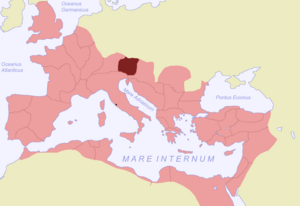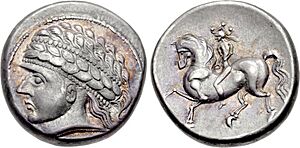Noricum facts for kids
Quick facts for kids Province of Noricum
Provincia Noricum
|
|||||||||||||
|---|---|---|---|---|---|---|---|---|---|---|---|---|---|
| Province of the Roman Empire | |||||||||||||
| 16 BC–476 | |||||||||||||
 The province of Noricum in 125, in the reign of emperor Hadrian. |
|||||||||||||
| Capital | Virunum | ||||||||||||
| Historical era | Antiquity | ||||||||||||
|
• Incorporated into the province
|
16 BC | ||||||||||||
|
• Divided to Noricum Ripense and Noricum Mediterraneum
|
c. 296 | ||||||||||||
|
• Odoacer's conquest and incorporated with his Italian Realm
|
476 | ||||||||||||
|
|||||||||||||
Noricum was the Latin name for an ancient kingdom or group of tribes. This area covered most of what is now Austria and part of Slovenia. Around the first century AD, it became a province of the mighty Roman Empire.
Noricum's borders were the Danube River to the north. To the west were Raetia and Vindelici. Pannonia was to the east and south-east. Finally, Italia was to the south. The kingdom started around 400 BC. Its main city, or capital, was Virunum, located on the Magdalensberg.
Contents
Ancient Noricum: Land and People
Around 800 BC, people of the Hallstatt culture lived in this region. By 450 BC, they joined with groups from other parts of Germany and France. This created a unique mix of cultures.
A Land Rich in Resources
Noricum was a mountainous country. It was very rich in important natural resources like iron and salt. This iron was used to make weapons in nearby areas like Pannonia and Moesia. Even the Romans used Noricum's famous Noric steel for their weapons. The Roman poet Horace even mentioned the "Noric sword."
Gold and salt were also found in large amounts. A special plant called saliunca, similar to lavender, grew there too. People used it as a perfume, as noted by Pliny the Elder.
Daily Life and Trade
The people of Noricum developed a rich culture. They were skilled in art, salt mining, and raising cattle. They also practiced farming. When the Romans took over, they improved water systems. This helped increase the already important trade between people north and south of the Alps.
Archaeologists have learned a lot from old burial sites, especially in Hallstatt. These sites show that a strong civilization existed here long before written history. Graves contained weapons and ornaments from the Bronze Age and the early Iron Age.
History of Noricum
Noricum's Role in Roman Weaponry
The kingdom of Noricum was very important for the Roman army. It provided many weapons from the time of the mid-Republic. Roman swords were made from the best steel available then, called chalybs Noricus.
The strength of steel depends on what it's made of and how it's heated. Regular wrought iron from the ancient world was often too soft. But the iron ore from Noricum was special. It had a lot of manganese, which is key for strong steel. It also had very little phosphorus, which can weaken steel. The ore found in Carinthia, in southern Noricum, was perfect.
Around 500 BC, the Noricum people discovered their ore made superior steel. They built a large steel industry. At Magdalensberg, a major center, skilled blacksmiths made metal products and weapons. These finished weapons were then sent to Aquileia, a Roman city founded in 180 BC.
Becoming a Roman Ally
From 200 BC, the Noricum tribes slowly united into a kingdom. This kingdom was known as the Regnum Noricum. Its capital was a place called Noreia. Noricum became a key friend of the Roman Republic. They provided high-quality weapons and tools. In return, Rome offered military protection.
This friendship was clear in 113 BC. When the Teutones invaded Noricum, the Roman consul Gnaeus Papirius Carbo led an army to help. They fought the invaders at the Battle of Noreia.
Noricum Under Roman Rule
Noricum officially became part of the Roman Empire in 16 BC. Before this, the Noricans had been independent. They had their own rulers and traded a lot with the Romans. In 48 BC, they even supported Julius Caesar in his civil war against Pompey.
In 16 BC, Noricans joined with the Pannonians to invade Istria. They were defeated by Publius Silius Nerva. After this, Noricum was called a province. However, it still kept its own kingdom, called regnum Noricum, but it was controlled by a Roman official.
Under Emperor Claudius (41–54 AD), the Noricum Kingdom fully joined the Roman Empire. This happened without much fighting. Later, during the rule of Antoninus Pius, a Roman army unit, the Second Legion, was stationed in Noricum. The commander of this legion became the governor of the province.
Dividing the Province
Under Emperor Diocletian (245–313 AD), Noricum was split into two parts. These were Noricum ripense and Noricum mediterraneum. Noricum ripense was the northern part, along the Danube River. Noricum mediterraneum was the southern, more mountainous area.
Each part had its own leader. Both belonged to a larger Roman region called the diocese of Illyricum. Around this time (304 AD), a Christian soldier in Noricum was killed for his faith. He later became known as Saint Florian.
Important Roman Towns
Some of the main Roman towns and cities in Noricum included:
- Virunum (near Maria Saal)
- Teurnia (near Spittal an der Drau)
- Flavia Solva (near Leibnitz)
- Celeia (Celje) in modern Slovenia
- Juvavum (Salzburg)
- Ovilava (Wels)
- Lauriacum (Lorch at the mouth of the Enns River)
Much of what we know about Roman Noricum comes from the work of Richard Knabl. He was an Austrian expert on ancient writings in the 1800s. The book Life of Saint Severinus also tells us a lot about how Roman rule ended in Noricum.
See also
- List of Roman governors of Noricum
- Varisci



